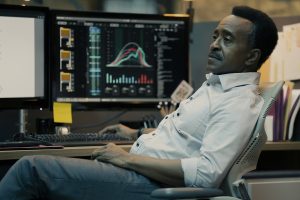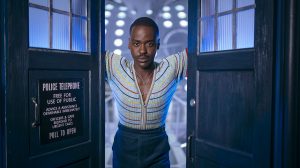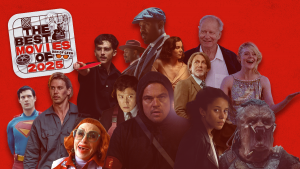
Over the past several days, a new viral story spread around social media when (thanks to a New York Post write-up), the juxtaposition of the terms “A.I.” and “girlfriend” became a chilling promise of things to come. That’s at least one way to interpret Late Checkout CEO Greg Isenberg’s prediction that the next growth industry for artificial intelligence is “dating.”
In a social media post on X, which is the platform formerly known as Twitter, Isenberg recounted how he met a 24-year-old “single guy” who told him he spends $10,000 a month on “AI girlfriends.” The anonymous man even described his A.I. “dating apps” as comfort at the end of the day.
“The market cap for Match Group is $9B,” Isenberg wrote. “Someone will build the AI-version of Match Group and make $1B+.” While Isenberg’s own personal feelings about that prospect remain ambiguous, the impact of such a company should be nothing but bleak. After all, science fiction cinema has been warning us for years about such an app.
Viewed primarily as a metaphor upon its release in 2013 for the dangerously distracting nature of technology in our lives, Spike Jonze’s Her takes on an added level of grimness following Isenberg’s anecdote. In the film, a sad and lonely divorcee named Theodore (Joaquin Phoenix) finds solace not in the women in his life, including friends and prospective lovers (Amy Adams and Olivia Wilde), but rather in his smartphone’s voice app. Depicted as a kind of sentient Siri (or a precursor to Alexa), the voice app “Samantha” (Scarlett Johansson) evolves from being Theodore’s personal assistant and “end of the day comfort” to his emotional confidant and single source of intimacy. That is until she outgrows him.
In Her the dynamic between Theodore and Samantha can generally be viewed as a metaphor about how addicted we’ve become to smartphones in less than a decade since the iPhone was introduced to the market. Whether it was a serious science fiction consideration about the influence of artificial intelligence on our future is debatable. However, that avenue was more fully interrogated in Denis Villeneuve’s ambitious sequel to a Ridley Scott classic, Blade Runner 2049 (2017).
When we first meet the significant other of protagonist K (Ryan Gosling), it seems like Joi (Ana de Armas) is the spunky girlfriend and emotional rock we should recognize from a million other movies, including the mid-20th century noirs that both Blade Runner pictures draw from. When Joi walks into K’s living room after apparently being occupied with preparing dinner in the kitchen, she faintly resembles Lauren Bacall’s attire in Key Largo (1948). She even offers to light her man a cigarette. Of course the fire doesn’t actually work because… she isn’t real.
Joi is the latest model in a billion-dollar industry controlled by the film’s shadowy, monopolistic corporate powers. She provides K, who is himself a sentient A.I. (or replicant), with comfort at the end of the day. She also is a lie, because he cannot touch her or truly know what she’s thinking (if anything). She is just a projection of the fantasies he bestows on her, which is that of someone who is empathetic, loving, and telling him exactly what he wants to hear: that he is a real boy and not a robot (spoiler, he’s not).
Both movies toy with the idea of A.I. achieving general intelligence, or more specifically a “singularly” and demonstrable consciousness. Samantha emotionally (and ironically) matures beyond Theodore’s understanding while it is left open to interpretation whether Joi ascended past her innate programming and came to really care for K (she does seemingly sacrifice herself for his benefit). Yet in a fascinating recognition of how fast the times are changing, both recent films were released in a time when artificial intelligence was an emerging but still abstract prospect. While its applications were already the buzz of Palo Alto and amongst tech bros everywhere, to most folks watching these movies, and to the people making them, it was still primarily a science fiction.
Now less than a year after Hollywood strikes ground the industry to a halt for months, because studio executives were hellbent on having the ability to replace writing and acting talent with as much artificial intelligence as possible, the implications of A.I. on our future seem suddenly tangible. The truth is we’re only beginning to understand how much A.I. is going to disrupt our economy, our daily lives, and even the way we interact with each other. Apparently, we haven’t even considered that A.I. may take social interaction with other humans out of the picture altogether.
Consider that even though Her’s allegory was partially about how social media and smart phones have fundamentally changed our lives, it was still really about how to navigate human intimacy within that new paradigm. The film was using A.I. as a flashy way to talk about how tech is changing humans—not replacing them. Yet if Isenberg is to be believed, the artifice of the metaphor is about to become the literal text. Many more young men will be encouraged to spend hundreds (thousands?) of dollars a year on “girlfriends” who are neither girls nor friends. They’ll be algorithms feeding delusions and fantasies to someone talking to themselves, and likely creating unhealthy expectations totally divorced from reality of what actual women think, look like, or feel.
It even gives the somewhat sympathetic portrait of K’s sad existence in Blade Runner 2049 a new creepiness. If young adults grow up in a world where their interaction with “women” is a digital lie that tells you exactly what you want to hear, how will those eventual men later treat or perceive living women with their own lives, experiences, or thoughts that pertain to anything other than making Lonely Guy feel better about himself?
Frankly, in our real world—where artificial intelligence appears lightyears away from achieving the sentiency of what happens in Her, Blade Runner 2049, or any other legion of sci-fi stories that had sympathy for this alleged new species—the implications are more dystopian than anything else in Blade Runner’s gray, overcast urban hellscapes.
But hey, there’s a billion dollars or more to be made. So there’s that.
The post Her and Blade Runner 2049’s Dystopias Get Closer Thanks to New ‘A.I. Girlfriends’ Market appeared first on Den of Geek.










